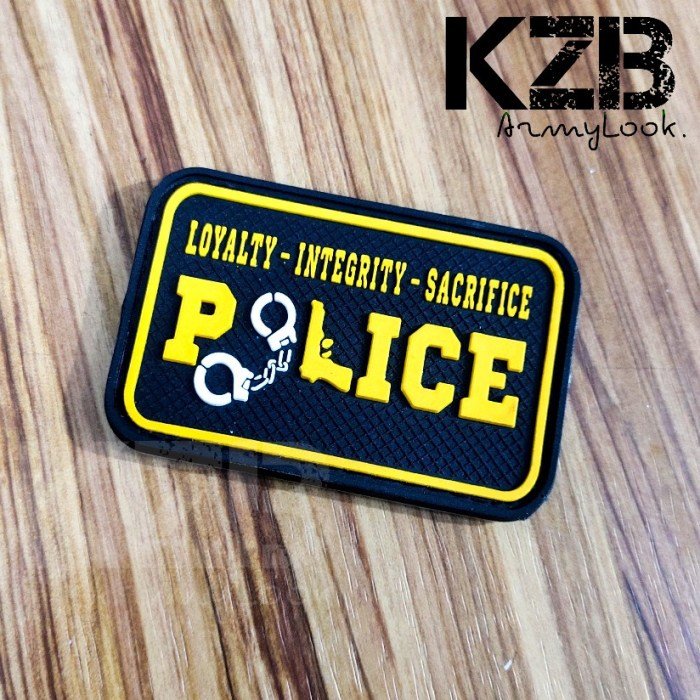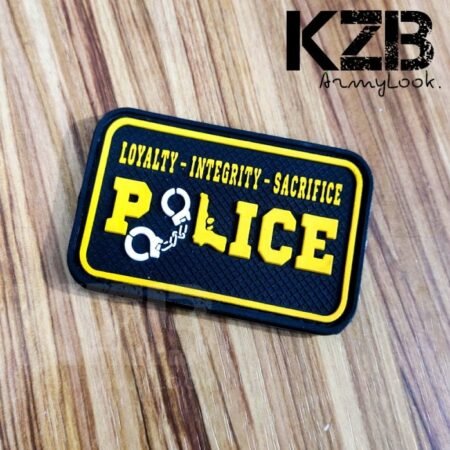
Maritime law enforcement agencies worldwide utilize a variety of patches, often secured with Velcro, to denote rank, unit, or specialization. These patches aren’t mere adornments; they represent a rich history, complex symbolism, and adherence to strict regulations. Their design, procurement, and even the seemingly simple Velcro attachment reflect a blend of tradition, practicality, and legal considerations.
This exploration delves into the multifaceted world of maritime law enforcement patches, examining their diverse types, the intricacies of their Velcro attachment, the procurement processes involved, design aesthetics, legal implications, and a fascinating historical overview. We’ll uncover the stories embedded within these seemingly small emblems, highlighting the significance they hold for the individuals who wear them and the agencies they represent.
Types of Maritime Law Enforcement Patches

Maritime law enforcement agencies worldwide utilize a diverse range of patches, reflecting their unique identities, jurisdictions, and operational roles. These patches serve not only as identifying insignia but also as symbols of authority, pride, and shared purpose within the maritime law enforcement community. Variations in design, material, and size reflect the differing organizational structures and operational contexts of these agencies.
Patch Design Variations
The designs of maritime law enforcement patches are incredibly varied. Some feature national flags or emblems, showcasing allegiance to a specific country. Others incorporate imagery related to the agency’s specific duties, such as ships, nautical symbols (anchors, compasses, life preservers), or stylized depictions of marine wildlife. Many patches include the agency’s name or motto, often in a stylized font reflecting the agency’s overall aesthetic. Color schemes often reflect the colors of the agency’s uniforms or national flag. For example, a patch might feature a dark blue background representing the sea, with a gold or silver emblem symbolizing authority and prestige. The level of detail can vary significantly, from simple, minimalist designs to highly intricate and detailed artwork. Some patches incorporate three-dimensional elements, such as embroidered threads or raised lettering, adding texture and depth to the design.
Patch Materials and Sizes
Maritime law enforcement patches are typically made from durable materials designed to withstand the harsh conditions of maritime environments. Common materials include embroidered woven patches, PVC patches, and high-quality printed patches. Embroidered patches offer a high degree of detail and longevity, while PVC patches are often chosen for their water resistance and durability. Printed patches can provide a wide range of color options and detailed imagery at a lower cost. The size of patches varies considerably, ranging from small, lapel-sized patches to larger patches suitable for jackets or vests. The size often correlates with the rank or position of the wearer, with higher-ranking officers sometimes sporting larger patches.
Symbolism and Imagery
Recurring motifs on maritime law enforcement patches frequently include nautical symbols representing maritime authority and tradition. Anchors, for instance, symbolize stability and steadfastness, reflecting the importance of maintaining order and security at sea. Ships, often depicted in profile or as stylized representations, symbolize the agency’s operational reach and capability. The use of crests, coats of arms, or other heraldic symbols can represent national identity or the specific history and traditions of a particular agency. Marine animals, such as eagles or dolphins, can be used to evoke a sense of strength, power, and protection. The incorporation of specific colors often holds symbolic meaning; for example, blue often represents the sea, while gold or silver might symbolize authority or prestige. The overall design aims to communicate the agency’s mission, values, and role in maintaining maritime security.
Examples of Maritime Law Enforcement Patches
| Agency/Country | Patch Description | Materials | Unique Identifying Features |
|---|---|---|---|
| United States Coast Guard | Often features the Coast Guard emblem (a shield with an eagle and a life preserver) and the agency’s motto. | Embroidered, woven | Distinctive emblem, often incorporates the agency’s motto “Semper Paratus” (Always Ready). |
| Royal Canadian Mounted Police (Marine Division) | Typically incorporates the RCMP crest and imagery related to maritime operations. | Embroidered, woven | Incorporates the RCMP’s iconic red and gold color scheme. |
| UK Border Force Maritime | May feature the UK flag or a crown, often with maritime-related imagery. | Embroidered, PVC | Often includes the agency’s name and motto. |
| Australian Border Force Maritime | Usually features the Australian flag or coat of arms and maritime symbols. | Embroidered, printed | May incorporate a stylized representation of the Australian coastline. |
Velcro Attachment Mechanisms
Maritime law enforcement patches frequently utilize Velcro for secure and easily removable attachment to uniforms. This allows for quick changes of patches based on operational needs or unit assignments. Several types of Velcro systems exist, each with its own advantages and disadvantages in this context.
The choice of Velcro system depends on factors such as the patch’s size, weight, and the frequency of attachment and detachment. The durability and environmental conditions the patch will face also influence the selection.
Types of Velcro Systems for Maritime Law Enforcement Patches
Several types of hook-and-loop fasteners are available, each offering varying degrees of strength and durability. Common types include standard hook-and-loop, heavy-duty hook-and-loop, and self-adhesive hook-and-loop. Standard hook-and-loop provides a reliable attachment for lighter patches, while heavy-duty versions are better suited for larger, heavier patches or situations demanding greater holding power. Self-adhesive options simplify the attachment process, eliminating the need for sewing. However, self-adhesive Velcro may not be as durable as sewn-on versions, especially in harsh maritime environments.
Manufacturing Process for Velcro-Backed Patches
The manufacturing process for a Velcro-backed patch involves several key steps. First, the patch design is created and printed onto a suitable material, such as embroidered fabric or woven nylon. Then, the hook or loop side of the Velcro is applied to the back of the patch. For sewn-on Velcro, a specialized sewing machine precisely attaches the Velcro strip to the patch’s edge, ensuring even distribution and strong adhesion. For self-adhesive Velcro, a pressure-sensitive adhesive is applied to the back of the Velcro, allowing it to be directly adhered to the patch. The patch is then inspected for quality control before packaging. The choice between sewing and adhesive application influences the overall durability and longevity of the patch. Sewn Velcro tends to offer superior durability and longevity compared to adhesive Velcro, particularly in wet or harsh conditions frequently encountered in maritime environments.
Diagram of Velcro Attachment System
Imagine a rectangular patch. On the back of the patch, a strip of loop Velcro is sewn along the entire top edge. This loop Velcro is soft and fuzzy, resembling a pile of short fabric fibers. The opposing side, typically found on the uniform, contains a strip of hook Velcro. This hook Velcro consists of small, stiff plastic hooks that interlock with the loops on the patch’s Velcro. The interlocking of these hooks and loops creates a strong bond, securely attaching the patch to the uniform. The strength of the attachment depends on the density and quality of both the hook and loop materials, as well as the method of attachment (sewing versus adhesive). The diagram would visually represent this, showing the hook and loop material textures, their relative positions, and how they interlock to create the secure fastening. A key would indicate the patch material, the loop Velcro, and the hook Velcro.
Procurement and Sourcing of Patches
Maritime law enforcement agencies procure patches through a formal process that ensures quality, adherence to specifications, and cost-effectiveness. The procurement method often depends on the agency’s size, budget, and the complexity of the patch design and quantity required. Smaller agencies might handle procurement internally, while larger ones may utilize centralized purchasing departments or contract with specialized procurement services.
The typical procurement process involves several key steps. First, a need for patches is identified, often stemming from new uniform requirements, replacements for worn patches, or the introduction of new units or designations. This leads to the creation of a formal request, outlining the required number of patches, specifications (size, materials, design, attachment method), and budget. This request is then submitted for approval through established internal channels. Once approved, the agency typically issues a request for quotation (RFQ) or a request for proposal (RFP) to potential suppliers. Suppliers submit their bids, which are evaluated based on price, quality, delivery timelines, and adherence to specifications. The agency then selects a supplier and negotiates the final contract, which includes detailed terms and conditions, payment schedules, and delivery expectations. Finally, the patches are delivered and inspected to ensure compliance with the contract.
Sources of Patches
Maritime law enforcement agencies obtain patches from a variety of sources, each with its own advantages and disadvantages. Manufacturers offer the benefit of direct control over the production process, allowing for greater customization and potentially higher quality. However, they may have higher minimum order quantities and longer lead times. Distributors act as intermediaries, offering a wider selection of pre-made patches from various manufacturers, leading to faster delivery times and potentially lower minimum order quantities. However, their customization options are typically limited. Custom suppliers specialize in creating unique patch designs and often cater to smaller orders, providing high levels of customization. However, they often command higher prices. The choice of supplier depends on the agency’s specific needs and priorities, balancing cost, quality, customization options, and delivery timelines.
Patch Procurement Specifications and Requirements
Maritime law enforcement agencies often include detailed specifications and requirements in their procurement requests to ensure the patches meet their operational needs and standards. These specifications might include:
- Material: The type of material used, such as embroidered thread, woven fabric, or PVC, and its durability and weather resistance. For example, a requirement might specify “100% embroidered polyester thread, resistant to saltwater and UV degradation.”
- Size and Dimensions: Precise measurements of the patch’s height and width, ensuring proper placement on uniforms. For example, “Patch dimensions: 4 inches x 3 inches, with a ± 0.25-inch tolerance.”
- Design and Artwork: Detailed descriptions and artwork files of the desired patch design, including color specifications and fonts. This may include specific requirements regarding the agency’s logo, motto, or insignia.
- Attachment Method: Specification of the attachment mechanism, such as hook-and-loop (velcro) backing, ensuring compatibility with uniform fabrics. For example, “Hook-and-loop (velcro) backing, ensuring secure attachment to uniform material.”
- Quantity: The total number of patches required, which impacts pricing and production timelines.
- Packaging and Labeling: Requirements for packaging and labeling to protect the patches during shipping and storage, and for inventory management.
- Quality Control: Specifications for quality control inspections to ensure adherence to standards and minimal defects. For example, “100% inspection for defects before shipment.”
Patch Design and Aesthetics
Maritime law enforcement patches, while functional, also serve as powerful visual representations of an agency’s identity and mission. Careful consideration of design elements is crucial to creating a patch that is both professional and easily recognizable. Effective design communicates authority, professionalism, and the agency’s unique role in maritime security.
The visual appeal of a maritime law enforcement patch is intrinsically linked to its effectiveness. A well-designed patch instantly conveys a sense of authority and professionalism, fostering respect and compliance. Conversely, a poorly designed patch can undermine the agency’s credibility. The aesthetics must reflect the agency’s values, history, and operational context.
Common Design Elements and Their Rationale
Maritime law enforcement patches frequently incorporate specific symbols and color schemes to represent their function and jurisdiction. Common design elements include nautical imagery such as anchors, ships’ wheels, or stylized waves, reflecting the maritime environment. The use of national colors or agency-specific colors reinforces affiliation and identity. Bold, easily readable fonts ensure the patch’s text is clearly visible from a distance. For example, a patch featuring a stylized Coast Guard cutter alongside a national flag and the agency’s motto in a clear sans-serif font would effectively communicate the agency’s identity and mission. The choice of colors often relates to the agency’s overall branding, with navy blue and gold being frequently used to convey authority and tradition.
The Role of Aesthetics in Reflecting Agency Identity and Mission
Aesthetics play a crucial role in establishing an agency’s visual identity. The design of a patch should reflect the agency’s core values, history, and operational focus. For instance, a patch emphasizing a bold eagle might represent a focus on national security, while a patch showcasing a lighthouse could symbolize guidance and safety at sea. The choice of colors, symbols, and fonts all contribute to the overall message conveyed by the patch. A cohesive aesthetic across all agency materials, including uniforms and vehicles, further reinforces brand recognition and strengthens the agency’s public image.
Design Principles for Maritime Law Enforcement Patches
Creating a durable and professional-looking patch requires adherence to specific design principles. Prioritizing high-quality materials is essential for longevity. The patch should be resistant to fading, tearing, and shrinking, ensuring its appearance remains crisp and professional even after extended use. The design should be clear, concise, and easily recognizable. Complex designs can be difficult to reproduce accurately and may lack the impact of a simpler, more focused design. The color scheme should be chosen carefully, considering both visibility and the agency’s brand guidelines. Finally, the chosen font should be legible and appropriate for the overall aesthetic of the patch. A well-designed patch is a reflection of the agency’s professionalism and attention to detail.
Legal and Regulatory Considerations
The design and use of maritime law enforcement patches, while seemingly minor details, are subject to a complex web of legal and regulatory requirements. Understanding these regulations is crucial for agencies to ensure compliance and avoid potential legal pitfalls. This section will explore the key legal considerations surrounding these patches, focusing on design, usage, and intellectual property.
The legal landscape governing maritime law enforcement patches is multifaceted, encompassing intellectual property rights, trademark law, and regulations pertaining to official insignia. These laws vary depending on the jurisdiction and the specific agency involved. Failure to comply can lead to significant legal repercussions, including fines, lawsuits, and reputational damage.
Intellectual Property Rights
Unauthorized reproduction or use of maritime law enforcement patches can constitute infringement of intellectual property rights. This includes copyright infringement, if the patch design is original and protected, and trademark infringement, if the patch incorporates a protected logo or symbol. For example, the unauthorized replication of a Coast Guard patch for commercial sale would be a clear violation of copyright and potentially trademark law, depending on the specific elements of the design. Agencies must ensure that their patch designs do not infringe on existing intellectual property rights held by others. This includes thorough searches of existing trademarks and copyrights before finalizing a patch design. Failure to do so can result in costly legal battles and the necessity of redesigning the patches.
Unauthorized Reproduction and Use
The unauthorized reproduction and use of maritime law enforcement patches can have serious consequences. This applies not only to the unauthorized mass production and sale of patches but also to the unauthorized wearing of patches by individuals or entities not affiliated with the relevant agency. Such actions could be seen as impersonation or an attempt to mislead the public, leading to potential legal action. For example, an individual selling counterfeit Coast Guard patches could face criminal charges for trademark infringement and potentially fraud. Similarly, unauthorized use of a patch by a private security firm could create confusion and raise concerns about legitimacy. Clear guidelines and policies regarding the appropriate use and distribution of patches are essential for agencies to prevent such issues.
Regulations Pertaining to Official Insignia
Many jurisdictions have specific regulations concerning the use of official insignia, including law enforcement patches. These regulations often dictate the permitted design elements, materials, and authorized wearers of such insignia. Unauthorized alteration or use of official insignia can be a criminal offense. For example, a regulation might prohibit the use of certain colors or symbols, or it might restrict the sale of patches to authorized personnel only. Agencies must be aware of and comply with all relevant regulations concerning the design and use of their patches to avoid legal repercussions. This requires careful review of local, regional, and national laws pertaining to official insignia and maritime law enforcement. Non-compliance can result in disciplinary action for personnel and legal challenges for the agency itself.
Historical Context of Maritime Law Enforcement Patches
Maritime law enforcement patches, while seemingly a minor detail of uniform adornment, offer a fascinating glimpse into the evolution of maritime security and the organizations responsible for maintaining order at sea. Their design and symbolism reflect not only the changing priorities of these agencies but also broader societal shifts and technological advancements within the maritime world. Tracing their history reveals a compelling narrative of evolving roles, responsibilities, and visual identity.
The earliest examples of patches resembling modern maritime law enforcement insignia are difficult to definitively pinpoint due to a lack of comprehensive historical records. However, we can infer their development by examining the evolution of uniforms and organizational structures within various maritime agencies. Early maritime law enforcement, often undertaken by naval forces or customs officials, likely lacked standardized patches as we know them today. Instead, identification might have relied on uniform components, rank insignia, or ship affiliations. The emergence of dedicated coast guard and maritime police forces in the late 19th and early 20th centuries marked a turning point, leading to the gradual adoption of more formalized insignia, including patches.
Early Patch Designs and Symbolism
The earliest maritime law enforcement patches often featured simple designs, reflecting the relatively straightforward nature of their roles. Common motifs included stylized anchors, ships’ wheels, or national emblems, symbolizing maritime authority and connection to the nation-state. For example, a hypothetical early 20th-century U.S. Coast Guard patch might have displayed a simple anchor and the agency’s initials within a circular border. The limited color palettes of early patches often reflected the available dyes and manufacturing techniques of the time, frequently consisting of basic colors like navy blue, gold, and red.
Mid-20th Century Developments: Specialization and Technological Advancements
The mid-20th century witnessed significant changes in maritime law enforcement. The rise of organized crime, smuggling, and the need for effective interdiction at sea led to the specialization of roles and the expansion of agencies. This diversification is reflected in patch designs. Patches began to incorporate more detailed imagery, reflecting specific units or functions within the larger organization. For instance, a narcotics enforcement unit might have added a stylized drug-prevention symbol to their existing patch design. The advent of new technologies, such as radar and faster vessels, also influenced patch design, sometimes subtly incorporating symbolic elements representing these advancements. The use of more vibrant colors and advanced embroidery techniques also became more common.
Late 20th and Early 21st Century Patches: Globalization and Counter-Terrorism
The late 20th and early 21st centuries have seen an increasing emphasis on international cooperation and counter-terrorism efforts within maritime law enforcement. Patches reflect this shift through the inclusion of international symbols, collaborative logos, or designs that allude to counter-terrorism operations. Moreover, the influence of graphic design trends has led to more sophisticated and aesthetically pleasing patches. The incorporation of computer-aided design (CAD) in patch creation allowed for more intricate detail and the use of diverse color schemes.
Timeline of Key Milestones
A comprehensive timeline would require extensive research into the individual histories of various maritime law enforcement agencies worldwide. However, some general milestones can be identified:
- Late 19th – Early 20th Century: Emergence of dedicated maritime law enforcement agencies and the initial adoption of rudimentary insignia.
- Mid-20th Century: Increased specialization within agencies, leading to more diverse patch designs reflecting specific units and functions. Improved embroidery techniques and color palettes.
- Late 20th – Early 21st Century: Emphasis on international cooperation and counter-terrorism reflected in patch designs. Increased use of CAD and advanced design techniques.
Ending Remarks
From the historical evolution of their designs to the modern-day legal frameworks governing their use, maritime law enforcement patches offer a captivating glimpse into the world of maritime security. The seemingly simple Velcro attachment is just one element within a complex system that reflects the professionalism, tradition, and dedication of these agencies. Understanding these patches provides insight into the organizations that safeguard our seas and the individuals who serve within them.
Question & Answer Hub
What types of Velcro are used on maritime law enforcement patches?
A variety of hook-and-loop systems are employed, ranging from standard commercial-grade Velcro to more durable, specialized types designed for extreme conditions.
How are patches cleaned without damaging the Velcro?
Hand-washing with mild detergent is generally recommended. Avoid harsh chemicals or abrasive cleaning methods.
Can I purchase these patches directly from the agencies?
Generally, no. Most agencies procure patches through specialized suppliers or manufacturers adhering to strict specifications.
What happens if a patch is damaged or lost?
Procedures vary by agency, but typically replacement patches are requested through official channels.


